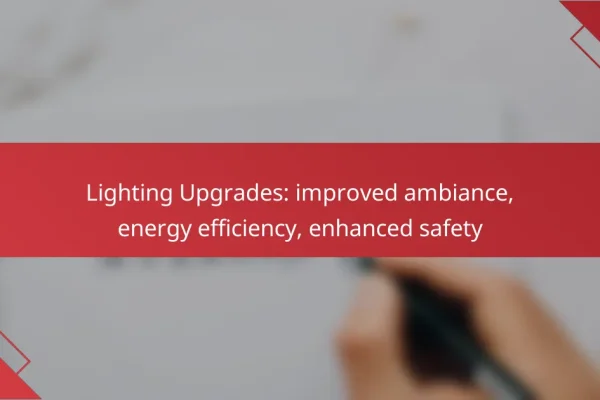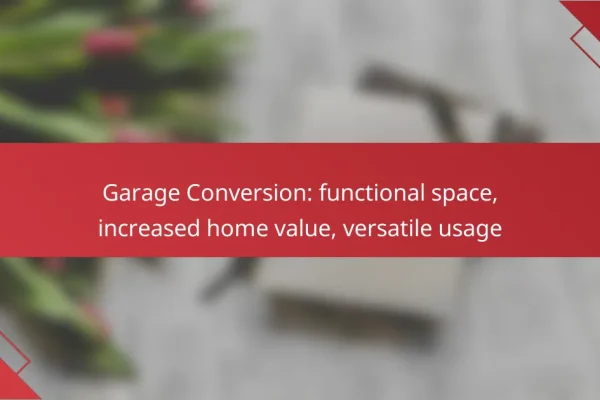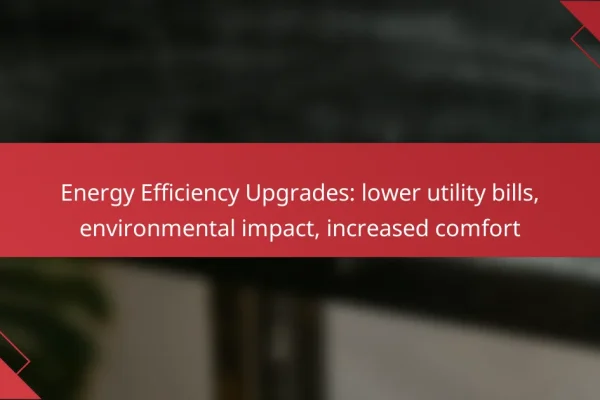
Lighting Upgrades: improved ambiance, energy efficiency, enhanced safety
Upgrading lighting in your home can transform the ambiance, making spaces feel warmer and more…
Home improvement projects can significantly enhance the functionality, aesthetics, and value of your property. From kitchen renovations to garden landscaping, each project offers unique benefits that cater to personal needs and preferences. It's essential to assess your budget and the potential return on investment when selecting the right project for your home.

Upgrading lighting in your home can transform the ambiance, making spaces feel warmer and more inviting while enhancing comfort and mood. Additionally, modern lighting solutions, especially LEDs, provide impressive energy efficiency, helping to lower utility bills and reduce environmental impact. Improved lighting also boosts safety by increasing visibility, which can deter crime and minimize accidents…

Energy efficiency upgrades offer a practical solution for reducing energy costs while enhancing comfort and minimizing environmental impact. By investing in better insulation, energy-efficient appliances, and smart technology, households and businesses can enjoy immediate savings and contribute to a more sustainable future. These improvements not only lower utility bills but also promote a healthier living…

Interior painting is a powerful tool for transforming your home, offering a refreshed appearance that captivates both residents and potential buyers. By selecting the right colors and finishes, you can not only elevate the aesthetic appeal of your space but also increase its overall property value. A well-executed paint job creates a welcoming atmosphere, making…

Creating an effective home office setup is essential for maximizing productivity and achieving a healthy work-life balance. By focusing on ergonomic furniture, optimal lighting, and dedicated workspaces, you can minimize distractions and enhance comfort. Incorporating the right tools and technology further boosts functionality, ensuring that your home office supports both your professional and personal needs….

Converting a garage can significantly boost your home’s market value while providing additional functional space tailored to modern living. This transformation allows for versatile usage, such as a home office, guest accommodation, or fitness studio, making your property more appealing to potential buyers. How can garage conversion increase home value in the UK? Converting a…

Roof replacement is a valuable investment that provides improved protection from the elements, enhances your home’s curb appeal, and offers significant energy savings. By upgrading to modern materials and designs, homeowners can enjoy better insulation and reduced energy costs, all while increasing the longevity and efficiency of their property. What are the benefits of roof…

Transforming your interior space with a fresh coat of paint doesn’t have to break the bank. By selecting budget-friendly materials, considering DIY options, and planning your project during off-peak times, you can achieve stunning results without overspending. Additionally, understanding the timeline and necessary materials will ensure a smooth and efficient painting process. What are budget-friendly…

Siding replacement is a significant home improvement project that involves various cost factors, including material selection, labor expenses, and location. Choosing the right siding material not only affects the budget but also impacts the home’s aesthetics and energy efficiency. Additionally, the installation timeline can vary from a few days to a week, influenced by the…

Bathroom renovation is a strategic way to enhance comfort and modernize your space, incorporating amenities like walk-in showers and smart fixtures. Not only does this improve functionality and aesthetics, but it also significantly boosts your property’s resale value, appealing to potential buyers who prioritize updated bathrooms. Investing in a well-designed bathroom can yield substantial returns,…

Energy efficiency upgrades offer a practical solution for lowering utility bills while enhancing home comfort and reducing environmental impact. By implementing measures such as improved insulation, energy-efficient appliances, and smart technology, homeowners can enjoy significant savings and contribute to a more sustainable future. These upgrades not only optimize energy use but also create a healthier…
The best home improvement projects in the UK focus on enhancing functionality, aesthetics, and property value. Popular options include kitchen renovations, bathroom upgrades, and garden landscaping, each offering unique benefits and considerations.
Kitchen renovations can significantly increase the value of your home while improving your cooking and dining experience. Key considerations include layout changes, modern appliances, and storage solutions. Aim for a budget of £5,000 to £30,000, depending on the extent of the remodel.
When planning your kitchen renovation, consider the work triangle concept, which optimizes the distance between the sink, stove, and refrigerator. Avoid over-customizing your space, as potential buyers may prefer more neutral designs.
Bathroom upgrades are essential for enhancing comfort and functionality in your home. Simple updates like new fixtures, tiles, and lighting can make a significant impact, with costs typically ranging from £3,000 to £15,000. Consider adding energy-efficient features to save on utility bills.
Focus on maximizing space, especially in smaller bathrooms. Wall-mounted sinks and floating vanities can create an illusion of more room. Ensure that any plumbing work complies with local regulations to avoid future issues.
Garden landscaping improves outdoor aesthetics and can create a relaxing space for family and friends. Popular projects include planting trees, installing patios, and adding garden lighting. Budgeting between £2,000 and £10,000 is common, depending on the scope of work.
When landscaping, consider the local climate and soil conditions to choose suitable plants. Incorporate features like pathways and seating areas to enhance usability. Regular maintenance is crucial to keep your garden looking its best, so factor in ongoing costs as well.
Choosing the right home improvement project involves assessing both the potential increase in property value and your personal needs. Prioritize projects that align with your budget and enhance your living space while considering the return on investment.
To assess property value, start by researching recent sales of comparable homes in your area. Focus on improvements that typically yield high returns, such as kitchen remodels or bathroom upgrades, which can often recoup a significant portion of their costs.
Consider consulting with a local real estate agent to understand which renovations are most appealing to buyers in your market. They can provide insights into trends and preferences that may influence your decision.
Identifying personal needs requires evaluating how your current space serves you and your family. List the areas that require improvement, such as functionality, aesthetics, or energy efficiency, and prioritize them based on urgency and budget.
For example, if your family is growing, adding an extra bedroom or enhancing outdoor space may be more beneficial than a cosmetic upgrade. Always balance personal desires with practical considerations to ensure the project meets your long-term needs.
The costs of home improvement projects can vary significantly based on the type of work, materials used, and location. Homeowners should consider both labor and material expenses, as well as potential permits and inspections, to create a comprehensive budget.
Kitchen remodels typically range from a few thousand to tens of thousands of dollars, depending on the scope of the project. A minor remodel may cost around $10,000, while a major overhaul can exceed $50,000.
Key factors influencing costs include cabinetry, countertops, appliances, and flooring. For example, high-end materials like granite or custom cabinets can significantly increase the budget.
Bathroom renovations usually fall between $5,000 and $25,000, with factors such as size and design complexity playing a crucial role. A simple update with new fixtures and paint may cost less, while a full remodel with new plumbing and layout changes can be much pricier.
Consider prioritizing essential upgrades, such as plumbing and electrical work, before investing in aesthetics. Always account for potential unexpected expenses, which can arise during renovations.
Landscaping costs can vary widely, typically ranging from a few hundred to several thousand dollars. Basic lawn care and planting may be inexpensive, while extensive hardscaping or custom designs can escalate costs significantly.
When budgeting for landscaping, consider ongoing maintenance expenses as well. Hiring a professional landscaper can add to initial costs but may save time and ensure quality results.
Planning a home improvement project involves defining your goals, setting a budget, and creating a timeline. Start by identifying the specific improvements you want to make and how much you are willing to spend on them.
Establishing a timeline is crucial for keeping your home improvement project on track. Begin by determining the overall duration of the project, breaking it down into phases such as design, procurement, and construction.
Consider factors like the availability of materials and contractors, as well as potential weather delays if your project involves outdoor work. A typical home renovation can take anywhere from a few weeks to several months, depending on its complexity.
Hiring the right contractors can significantly impact the success of your home improvement project. Start by researching local professionals, checking their credentials, and reading reviews from previous clients.
Request multiple quotes to compare pricing and services, and ensure that the contractors you consider are licensed and insured. Clear communication about your expectations and budget is essential to avoid misunderstandings during the project.
Essential tools for home improvement include both power and hand tools that enable effective renovations and DIY projects. Having the right tools not only enhances efficiency but also ensures safety and quality in your work.
Power tools are crucial for larger renovation tasks, offering speed and precision. Common power tools include drills, saws, and sanders, which can significantly reduce the time required for cutting, shaping, and finishing materials.
When selecting power tools, consider their power source—cordless models offer mobility, while corded tools typically provide more consistent power. Always prioritize safety features, such as blade guards and automatic shut-offs, to minimize risks during use.
Hand tools are essential for smaller DIY projects and detailed work, providing control and finesse. Basic hand tools include hammers, screwdrivers, pliers, and measuring tapes, which are often sufficient for tasks like assembling furniture or hanging shelves.
Investing in quality hand tools can make a significant difference in your project outcomes. Keep your tools organized and well-maintained to ensure they perform effectively when needed. A simple checklist of must-have hand tools can help you stay prepared for various home improvement tasks.
Common mistakes in home improvement can lead to increased costs, delays, and unsatisfactory results. Awareness of these pitfalls can help homeowners plan better and execute projects more effectively.
One of the most frequent errors in home improvement is underestimating costs. Homeowners often overlook expenses such as materials, labor, and unexpected repairs, which can add up significantly. It's crucial to create a detailed budget that includes a contingency fund of around 10-20% for unforeseen issues.
For example, a kitchen remodel might initially seem affordable, but costs for plumbing, electrical work, and permits can quickly escalate. Always research and gather multiple quotes from contractors to get a realistic picture of potential expenses.
Ignoring necessary permits and local regulations can lead to serious complications during home improvement projects. Many municipalities require permits for structural changes, electrical work, or plumbing modifications. Failing to secure these can result in fines or the need to redo work to meet compliance.
Before starting any project, check with local authorities to understand what permits are required. This can save time and money in the long run, as well as ensure that your improvements are safe and up to code.